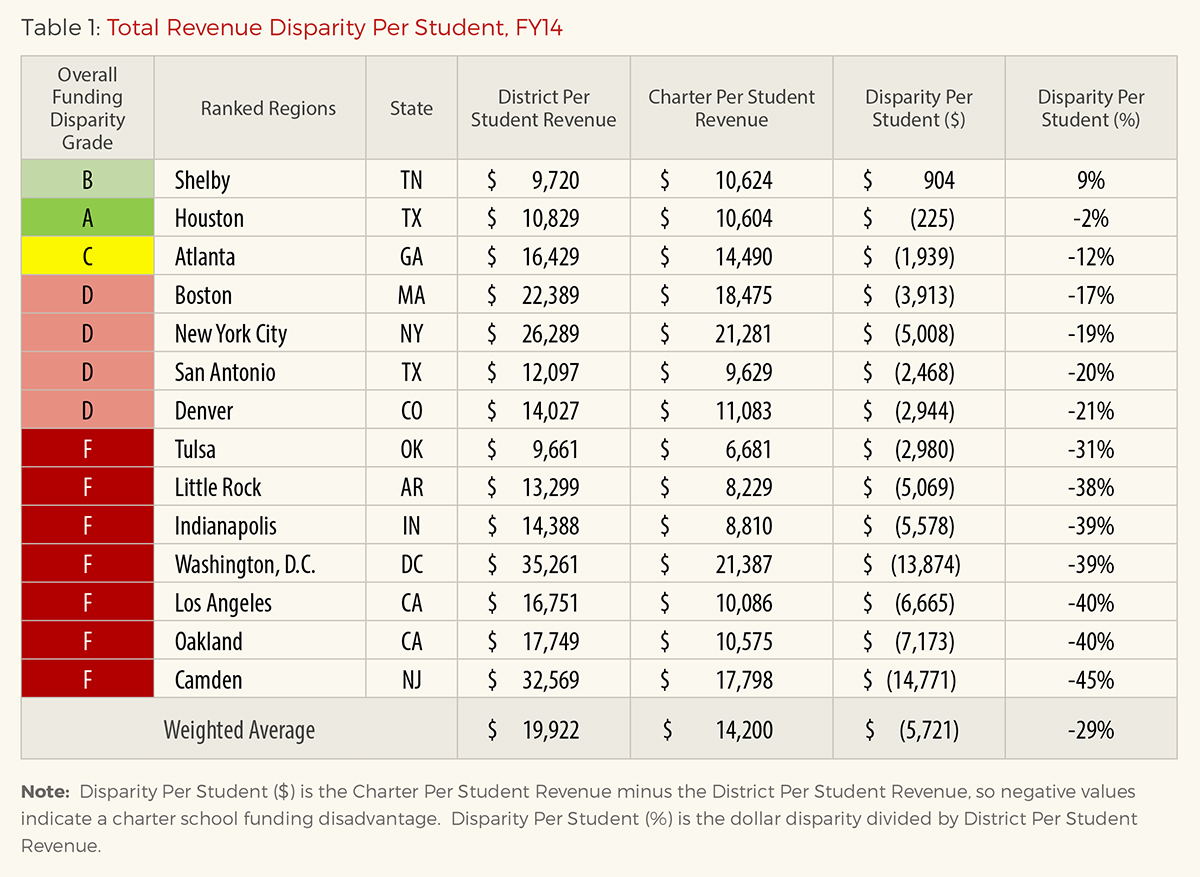We parents all have heard the claim that something wasn’t fair. “Suzie got a bigger piece of cake than I did!” “Tommy got to go fishing while I had to clean the garage!” “Malachi had a lot more money spent on his education because you sent him to a traditional public school and me to a public charter school!” Well, maybe we haven’t actually heard that last one very often but it would be a more legitimate gripe than the other ones.
Students in public charter schools receive $5,721 or 29% less in average per-pupil revenue than students in traditional public schools (TPS) in 14 major metropolitan areas across the U. S in Fiscal Year 2014. That is the main conclusion of a study that my research team released yesterday.
We include all revenue in our calculations, including nonpublic funds such as philanthropic donations. We also include facilities funding, which many TPS receive in the form of local millage increases or capital bond sales. Many charters do not receive facilities funding, instead paying for rented space out of per-pupil formula allocations. When charters do receive facilities funding it tends to be in the form of grants from the federal or state government or charities. Arrangements do vary somewhat by location. Washington, DC is exceptional in that facilities funding is included in its per-pupil charter funding formula.
Of the cities we examined, some have large and well-established charter sectors, like Houston, Los Angeles, New York, and Washington, while others have more emerging charter school sectors like Little Rock, San Antonio, and Tulsa.
Twelve of the 14 cities have a disturbing charter school funding gap of more than 10%, which earned them a C grade or lower. Tulsa, Little Rock, Indianapolis, Washington, Los Angeles, Oakland, and Camden earned an F for funding equity since there is a funding gap of more than 30% between what charter schools received versus what TPS received per pupil. Camden had the largest per-pupil funding gap in our study, with charter schools students receiving 45%, or $14,771, less per pupil than TPS students.
Shelby County, TN, which includes the city of Memphis, is the only metropolitan area in the study that funded students in public charter schools at a higher level than TPS. Shelby County charter students received $10,624 in per-pupil funding in FY 2014 compared to $9,720 per student in the county’s TPS. Houston’s charter schools were funded just 2% below their TPS, and earned the only grade of A in the study, in part because they were able to raise almost $900 per student in nonpublic revenue. Funding gaps of $1,500 per student or more for charters remained in 10 of the 14 cities even after excluding all special education expenditures from the comparison.
The main source of the funding gap is local revenues. Traditional public schools received $7,000 more per pupil in local revenues, on average, than did public charter schools. Charter schools are public schools, in local communities, that must enroll all students who want to attend (or hold a random admissions lottery). The parents of charter school students pay local taxes just like the parents of TPS students. The fact that eight of the 14 cities in our study provided essentially no local education revenue to their public charter schools is shameful. That’s simply not fair.
Our previous study of charter school funding equity at the state level was criticized for not exempting expenditures on such items as transportation and central administration that are mandatory for TPS but discretionary for public charter schools. In our view, that’s exactly the point. Charter schools are permitted to be innovative as an alternative to the more rigidly controlled administrative and spending structure of TPS. True, the revenue amounts received by charters and TPS are more even once you exclude all of the ways that district-run public schools are forced to be inefficient. Like I said. That’s exactly the point.
What are the takeaways for education policy? Our results support the recommendations of the Fordham Institute and others to fund students directly, using a weighted student funding formula, a.k.a. “backpack” funding. Placing public charter schools on a par with TPS in receiving local educational funds, as Colorado plans to do, would bring over half the cities in our study to funding parity across the two public school sectors.
States like Massachusetts, Texas, and Denver have tried to compensate for local funding discrepancies in their charter sectors by providing higher state funding to charter students, but that move hasn’t closed the funding gap. It merely got Houston close enough so that the extra-ordinary fundraising efforts of its charter schools were able to move charter students close to parity. Such bricolage arrangements are simple guesswork and no substitute for a rational student-based funding policy that treats the same student similarly regardless of the local public school their parent chooses for them. Ask your children. Anything else is just not fair.
— Patrick J. Wolf
Dr. Patrick J. Wolf is Professor and 21st Century Chair in School Choice in the Department of Education Reform at the University of Arkansas College of Education and Health Professions.



